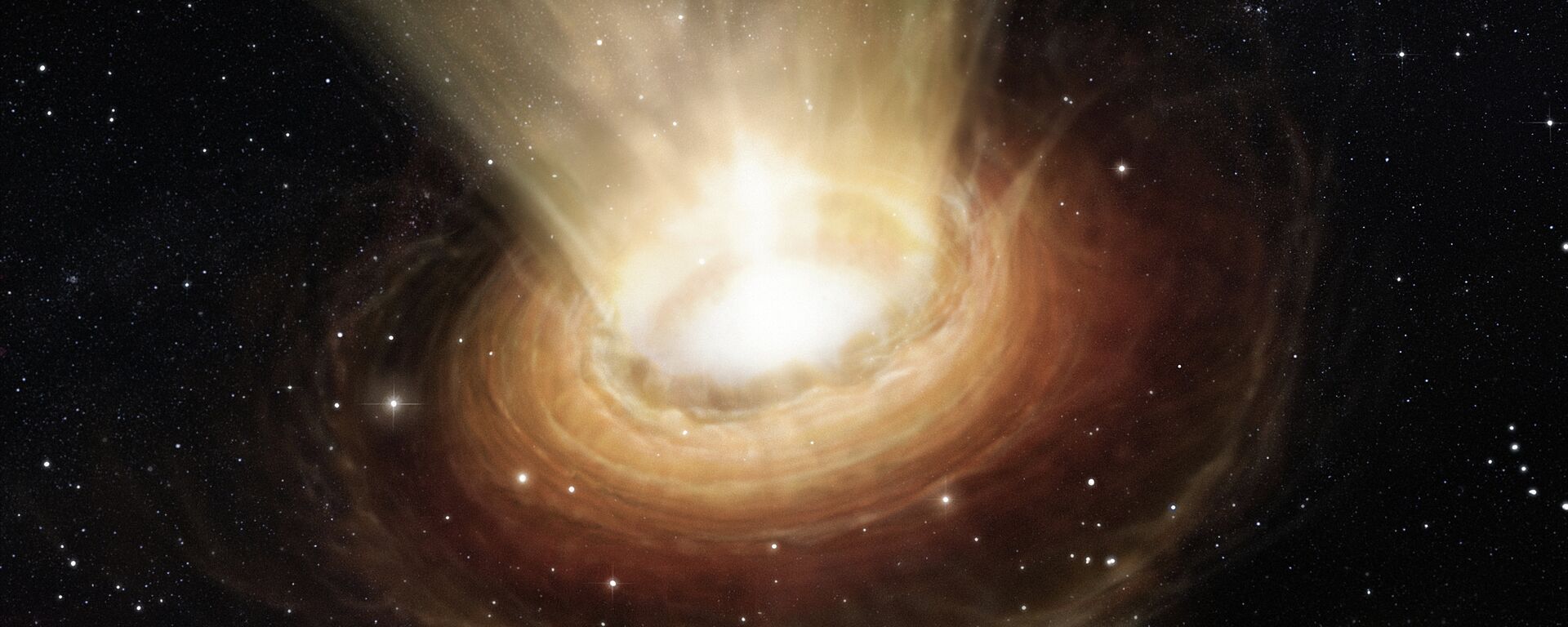https://sputnikglobe.com/20230621/black-holes-in-lonely-galaxies-found-to-be-hungrier-than-those-jostling-for-space--1111364555.html
Black Holes in Lonely Galaxies Found to Be Hungrier Than Those Jostling for Space
Black Holes in Lonely Galaxies Found to Be Hungrier Than Those Jostling for Space
Sputnik International
Solitary supermassive black holes at centers of galaxies residing in isolation are much more ferocious “eaters” than counterparts populating more crowded parts of cosmic space, new research has revealed.
2023-06-21T15:22+0000
2023-06-21T15:22+0000
2023-06-21T15:30+0000
beyond politics
science & tech
supermassive black hole
black hole
sloan digital sky survey (sdss)
https://cdn1.img.sputnikglobe.com/img/102386/79/1023867962_0:54:1024:630_1920x0_80_0_0_aec7cd0b8bf946003b6180083b96c6fc.jpg
Solitary supermassive black holes, located at the centers of galaxies residing in isolation, are much more ferocious “eaters” of stellar material than their counterparts populating more crowded zones of cosmic space, new research has revealed.To dig deeper into how black holes feed on stellar material, Anish Aradhey, a student at the Harrisonburg High School in Virginia and Anca Constantin, a professor of astrophysics at James Madison University, observed data from the Sloan Digital Sky Survey (SDSS) and NASA’s Wide-field Infrared Survey Explorer (AllWISE/NEOWISE) space telescope. It was the changing brightness of the over 290,000 galaxies they studied that led them to reveal that over 20,000 black holes that were "feeding" actively on surrounding gas and dust had not been detected earlier. This is because the studies had been utilizing optical or mid-infrared wavelengths. The so-called reclusive, or void galaxies which play host to a lot of star formations, emit bluer light emissions. It is these latter that are able to "drown out" the light emanating from feeding black holes.Now, the fluctuations in brightness of infrared light home in on the frenzy-feeding of black holes. Furthermore, it was discovered that they were displaying more activity in small or medium-size galaxies than large ones."The smaller galaxies seem to snack more effectively, if you will, when they are left alone and they don't interact with their neighbors," Aradhey said in a statement. Co-author Anca Constantin added:
https://sputnikglobe.com/20230512/supermassive-black-hole-triggered-largest-cosmic-explosion-in-history-1110284589.html
Sputnik International
feedback@sputniknews.com
+74956456601
MIA „Rossiya Segodnya“
2023
News
en_EN
Sputnik International
feedback@sputniknews.com
+74956456601
MIA „Rossiya Segodnya“
Sputnik International
feedback@sputniknews.com
+74956456601
MIA „Rossiya Segodnya“
supermassive black holes, centers of galaxies, ferocious eaters of stellar material, more crowded parts of cosmic space, new research, how galaxies evolve, reclusive galaxies
supermassive black holes, centers of galaxies, ferocious eaters of stellar material, more crowded parts of cosmic space, new research, how galaxies evolve, reclusive galaxies
Black Holes in Lonely Galaxies Found to Be Hungrier Than Those Jostling for Space
15:22 GMT 21.06.2023 (Updated: 15:30 GMT 21.06.2023) Less than 20% of all existing galaxies inhabit empty voids of space, enjoying no interaction with other galaxies, clarified the researchers, adding that the remaining 80% jostle about in crowded clusters as they gorge themselves on stellar material.
Solitary
supermassive black holes, located at the centers of galaxies residing in isolation, are much more ferocious “eaters” of stellar material than their counterparts populating more crowded zones of cosmic space, new research has revealed.
To dig deeper into how black holes feed on stellar material, Anish Aradhey, a student at the Harrisonburg High School in Virginia and Anca Constantin, a professor of astrophysics at James Madison University,
observed data from the Sloan Digital Sky Survey (SDSS) and NASA’s Wide-field Infrared Survey Explorer (AllWISE/NEOWISE) space telescope. It was the changing brightness of the over 290,000 galaxies they studied that led them to reveal that over 20,000 black holes that were "feeding" actively on surrounding gas and dust had not been detected earlier.
This is because the studies had been utilizing optical or mid-infrared wavelengths. The so-called reclusive, or void galaxies which play host to a lot of star formations, emit bluer light emissions. It is these latter that are able to "drown out" the light emanating from feeding black holes.
“Quantifying variations in the mid-infrared light of galaxies has the potential to detect black holes that traditional methods miss,” said Aradhey.
Now, the fluctuations in brightness of infrared light home in on the frenzy-feeding of black holes. Furthermore, it was discovered that they were displaying more activity in small or medium-size galaxies than large ones.
"The smaller galaxies seem to snack more effectively, if you will, when they are left alone and they don't interact with their neighbors," Aradhey said in a statement. Co-author Anca Constantin added:
"These findings challenge our current understanding of how galaxies evolve. They show that in these reclusive galaxies, the fuel generally available for star formation is channeled towards the central black hole somewhat more efficiently than in similar galaxies in the more crowded environments.”



